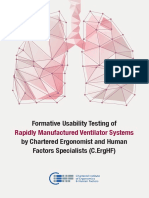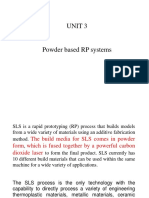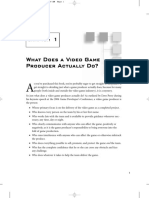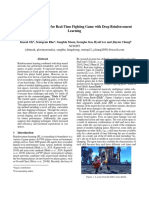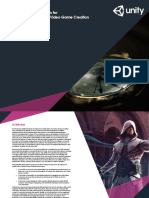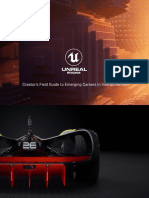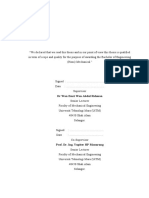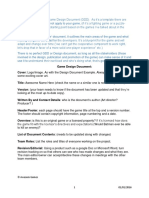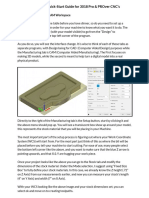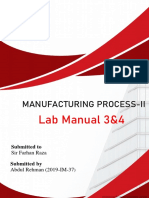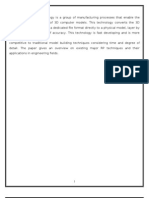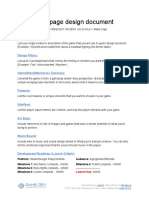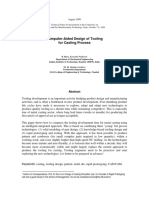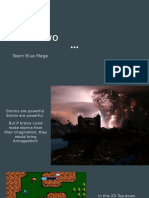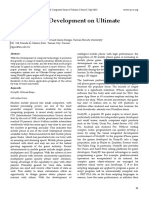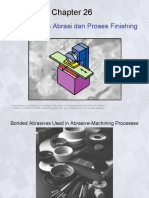100% found this document useful (1 vote)
417 views27 pagesRapid Prototyping
rapid prototyping
Uploaded by
Yoga KjCopyright
© © All Rights Reserved
We take content rights seriously. If you suspect this is your content, claim it here.
Available Formats
Download as PDF or read online on Scribd
100% found this document useful (1 vote)
417 views27 pagesRapid Prototyping
rapid prototyping
Uploaded by
Yoga KjCopyright
© © All Rights Reserved
We take content rights seriously. If you suspect this is your content, claim it here.
Available Formats
Download as PDF or read online on Scribd
/ 27
Rapid-Prototyping
Processes and
Operations
CHAPTER
‘© This chapter describes the technologies associated with rapid prototyping,
sharing the characteristics of computer integration, production without the use
of traditional tools and dies, and the ability to rapidly produce a single part on
demand; they all have the basic characteristics of producing individual parts
layer by layer
‘The chapter discusses the (nonmetallic and metallic) materials used in rapid
prototyping and describes the commercially important rapid-peotoryping
technologies.
+ These processes include fused-deposition modeling, stereolithography, multijet
modeling, polyjet modeling, three-dimensional printing, and selective laser
sintering,
+ The chapter ends with a description of the revolutionary practice of applying
rapid-prototyping techniques to the production of tooling (rapid tooling) that
can be used in other manufacturing processes.
Typical parts made: A wide variety of metallic and nonmetallic parts for product
design analysis, evaluation and finished products
Alternative processes: Machining, casting, molding, and fabricating.
20.1 Introduction
In the development of a new product, there is invariably a need to produce a single
example, o prototype, of a designed part or system before allocating large amounts
of capital to new production facilities or assembly lines. The main reasons for this
rneed are that the capital cost is very high and production tooling takes considerable
time to prepare. Consequently, a working prototype is needed for design evaluation
and troubleshooting before a complex product or system is ready to be produced
and marketed,
A typical product development process was outlined in Fig, 13 in the General
Introduction. An iterative process natutally occues when (a) errors are discovered or
(b) more efficient or better design solutions are gleaned from the study of an earlier
generation prototype. The main problem with this approach, however, is that the
20.1. introduction 525
202 Sobtractive
Processes 528
20.3. Additive Processes 530
204 Viral Prototyping 541
205. Direc Manufacturing
tnd Rapid Tooling 542
20.1 Functions Rapid
Prototyping 526
202 Coffeemaker Design 524
203. Production of Second
lies Avatars 537
204, Fuselage iting for
205
Fetes 547
20.1 Invisalign® Orthodontic
Alignes 543,
sas
526 Chapter 20
@
Rapid-Prottyping Processes and Operations
Cc) ©
a) selection of parts
FIGURE 20.1 Examples of parts made by rapi-protoryping processes:
from fused deposition modeling; (b)stereoithography model ofelular phone; and (c} selection
fof parts from three-dimensional printing, Source: (a) Courtesy of Stratasys, Ine, (b) and
(Courtesy of SD Systems, Inc
production of a prototype can be extremely time consuming. Tooling can take several
months to prepare, and the production of a single complicated part by conventional
manufacturing operations can be very difficult. Furthermore, during the time that a
prototype is being prepared, facilities and staf still generate costs.
An even more important concern is the speed with which a product flows
from concept to a markerable item. In a competitive marketplace, itis well known
that products that are introduced before those of their competitors generally are
more profitable and enjoy a larger share of the market. At the same time, there
are important concerns regarding the production of high-quality products. For
these reasons, there is a concerted effort to bring high-quality products to market
quickly.
‘A technology that speeds up the iterative product-development process consid
erably is the concept and practice of rapid prototyping (RP)—also called desktop
manufacturing, digital manufacturing,
‘or solid free-form fabrication. Examples of
apid-prototyped parts are shown in Fig. 20.1
EXAMPLE 20.1 Functional Rapid Prototyping,
‘Toys are examples of mass-produced products that
have universal appeal. However, some toys are actu-
ally quite complex, and the function of a computer
aided design (CAD) cannot be ensured until
prototypes are produced. Figure 20.2 shows a CAD
‘model and a rapid-prototyped version of a water
squire gun (Super Soaker Power Pack Back Pack™*
water gun), which was produced on a fused-deposition
modeling machine. Bach component was produced
separately and assembled into the squirt gun, and the
prototype could actually hold and squirt water. The
alternative would be to produce components on CNC
milling machines or fabricate them in another fashion,
but this ean be done only a much higher cos.
By producing a prototype, interference issues
and assembly problems can be assessed and corrected
Af necessary. Further, from an aesthetie standpoint, the
elaborate decorations on such a toy can be more
effectively evaluated feom a protorype than on a CAD
file and can be adjusted to improve the appeal of the
toy: Each component, having its design verified, then
has its associated tooling produced, with better
certainty thae the tooling as ordered will produce the
parts desired,
Section 20.1 Intoduetion 527
= CO)
FIGURE 20.2 Rapid protorping ofa SupeeSoaker™ squirt gun. (a) Fully functional toy produced through fased
deposition modeling; (b) orginal CAD description. Source: Courtesy of Rapid Mode and Prototypes, Incy and
Suratasys,
Developments in rapid prototyping began in the mid-1980s, The advantages
Of this technology include the following:
‘+ Physical models of parts produced from CAD data files can be manufactured
in a matter of hours and! allow the rapid evaluation of manufacturability and
design effectiveness. In this way, rapid prototyping serves as an important tool
for visualization and for concept verification,
* With suitable materials the prototype can be used in subsequent manufacturing
‘operations to produce the final parts. Sometimes called direct prototyping, this
approach can serve as an important manufacturing technology.
+ Rapid-protoryping operations can be used in some applications to produce actu
al tooling for manufacturing operations (rapid tooling, soe Section 20.5.1). Thus,
fone can obrain cooling in a matter of a few days.
Rapid-prototyping processes canbe classified into three major groups:
subtractive, additive, and virtual. As the names imply, subteactive processes involve
‘material removal from a workpiece that is larger than the final part, Additive processes
build up a part by adding material incrementally ro produce the part. Virtual processes
use advanced computer-based visualization technologies.
Almost all marerials ean be used through one or more rapid-prototyping oper:
ations, as outlined in Table 20.1. However, because their properties are more suit-
able for these operations, polymers are the workpiece material most commonly
used today, followed by metals and ceramics. Sill, new processes are being intro.
duced continually. The more common materials used in rapid-peototyping opera
tions are summarized in Table 20.2. This chapter is intended to serve as a general
introduction to the most common rapid-prorotyping operations, describe theie ad:
vantages and limitations, and explore the present and future applications of these
processes,
528 Chapter 20. Rapid-Protetyping Processes and Operations
‘TABLE 20.1
(Characteristics of Additive Rapid-prototyping Technologies
Layer creation ‘Type of
Process Supply phase technique phase change Macerials
Seercolithography Liquid Tiquid layer curing Photopolymerization — Phovopolymers acrylates,
epoxies, colorable
resins, and filled resins)
Mulsijer/payiee Liquid Liquid layer curing Photopolymerization Photopolymers
‘modeling
Fused-deposition Liquid Extrusion of melted Solidification by Polymers (such as ABS,
modeling polymer cooling, polycarbonate, and
polysulfone}
Ballistic particle Liquid Droplet deposition Solidification by Polymers and wax.
manufacturing cooling
‘Three-dimensional Powder Binder droplet No phase change Ceramic, polymer,
printing, depositi onto ‘metal powder, and
power layer sand
Selective laser sintering Powder Layer of powder Sintering or melting Polymees, metals with
binder, metals, ceramics
and sand with hinder
Electcon-heam melting Powder Layer of powder Melting Teanium and titanium
alloys, cobalt chrome
Laminated object Solid Deposition of sheet No phase change Paper and polymers
material
20.2 Subtractive Processes
Making a prototype traditionally has involved a series of processes using a variety of
tooling and machines, and ic usually takes anywhere from weeks to months, depend
ing on part complexity and size. This approach requires skilled operators using
material removal by machining and finishing operations (as described in detail in
Part IV)—one by one—until the prototype is completed. To speed the process,
subtractive processes increasingly use computer-based cechnologies such as the
following:
+ Computer-based drafting packages, which can produce three-dimensional rep
resentations of parts.
+ Interpretation software, which can translate the CAD file into a format usable
by manufacturing software.
+ Manufacturing software, which is capable of planning the operations required
to produce the desired shape.
+ Computer-numerical-control (CNC) machinery withthe capabilites necessary to
produce the parts.
‘When a prototype is required only for the purpose of shape verification, a soft
‘material (usually a polymer or a wax) is used as the workpiece in order to reduce or
avoid any machining difficulties. The material intended for use in the actual applica-
tion also can be machined, but this operation may be more time consuming, depend
jing on the machinability of the material. Depending on part complexity and
TABLE 20.2
‘Mechanical Properties of Selected Materials for Rapid Prototyping
Process
Material
“Tensile srength
(MPa)
Elastic modulus
Section 20.2 Subtracive Processes 529
Elongation in
50 mm (%)
Noes
Stereo
lithography
Poet
Fused
“deposition
‘modeling
Selective laser
sintering
Electron
beam
meking
Somos 71203
Somos 9120
‘WaterClear Ulea
‘Watershed 11122
DMX-SL 100
For
Fos30
F930
Polycarbonate
ABS-M305
rc
Draform PA
Doraform GF
SOMOS 201
ST-100e
Ti6alav
a
2
6
471-536
498
2
68
48
7
30s
970-1030
1s:
29
265-288
22-26
287
249
oss
20
24
228
40
ois
137
20
24d
1s.as
218
no
10
16
Transparent amber food general
purpose material fr rapid
protoryping
ansparent amber; good chemical
resistance; good fatigue properties
‘se for producing pater in rubber
molding
Optically clear eesin wi
properties
Oprially clear with a slight green
tinge; mechanical properties similar 0
thos of ABS; sed for rapid rong
‘Opaque beige: good general-purpose
material for rapid protoryping,
“Transparent amber; good impact
strength, good paine adsorption and
rmachinabality
White, blue, or black; good humidity
resistance; suitable fr genera
vxpose applications
Semiopague, gray, or black; highly
exile material used for protoryping
‘of soft polymers or rubber
‘White; high strength polymer suit-
able fr rapid procoryping and
sReneral wee
Available in multiple colors, most,
commonly white; strong and
‘durable material suitable for general
use: biocomparible
‘White; good combination of mechan
jeal properties and heat resistance
‘White; produces durable heat- and
chemical-resintant pars; suitable for
snap-fit assemblies and sandcasting
orsilicone tooling
‘White; lass illed form of Duraform
PAhas increased sifnes and is
suitable fr higher temperature
applications
“Multiple colors available; mimics
‘mechanical propertics of rubber
Bronze infiltrated steel powder
Can be heat rated by HIP to obtain
‘up to 600-MP fatigue strength
ABS ike
‘machining capabilities, prototypes can be produced in a few days to a few weeks.
Subtractive systems can take many forms; they are similar in approach to the manu-
facturing cells described in Section 39.2. Operators may of may not be involved,
although the handling of parts is usually a human task,
530
Chapter 20
Rapid Prototyping Processes and Operations
20.3 Additive Processes
Additive rapid-prototyping operations all build parts in layers, and as summarized
in Table 20.1, they consist of stereolithography, Multijet/polyjet modeling, fused-
deposition modeling, ballistic-particle manufacturing, three-dimensional printing,
selective laser sintering, electron-beam and laminated-object manufacturing. In
‘order to visualize the methodology used, itis beneficial ro think of constructing a
loaf of bread by stacking and bonding individual slices on top of each other, All of
the processes described in this section build parts slice by slice. The main difference
between the various additive processes lies in the method of producing the indivi
ual slices, which are typically 0.1 to 0.5 mm thick and can be thicker for some
systems,
‘All additive operations require elaborate software. As an example, note the
solid pare shown in Fig. 20.3a. The first step isto obtain a CAD file description of
the part, The computer then constructs slices of the three-dimensional part
(Fig, 20.3b), Each slice is analyzed separately, and a set of instructions is compiled in
‘order to provide the rapid-prototyping machine with detailed information regarding
she manufacture of the part. Fig. 20.3 shows the paths of the extruder in one slice,
using the fused-deposition-modeling operation described in Section 20.3.1.
“This approach requires operator input in the setup of the proper computer
files and in the initiation of the production process. Following that stage, the
machines generally operate unattended and provide a rough part after a few hours.
‘The partis then subjected to a series of manual finishing operations (such as sanding
and painting) in order to complete the rapid-prototyping process.
Te should be recognized that the setup and finishing operations are very labor
intensive and that the production time is only a portion of the time required to
obtain a protorype. In general, however, additive processes are much faster than
subtractive processes, taking as litte as a few minutes to a few hours to produce a
part
20.3.1 Fused-deposition Modeling
In the fused-deposition-modeling (FDM) process (Fig. 20.4), a gantry robot
controlled extruder head moves in two principal directions over a table, which can be
raised and lowered as needed. A theemoplastc filament is extruded through the small
orifice ofa heated die. The initial layer is placed on a foam foundation by extruding
the filament at a constant rate while the extruder head follows a predetermined path
{see Fig, 20.34), When the first layer is completed, the table is lowered so that subse-
quent layers can be superimposed.
Occasionally, complicated pasts are required, such as the one shown in
Fig. 20.58. This pare is dificule to manufacture directly, because once the part has
been constructed up to height a, the next slice would require the filament to be
placed ina location where no material exists beneath to support it.The solution is
to extrude a support material separately from che modeling material, as shown in
Fig. 20,5b, Note thatthe use of such support structures allows all ofthe layers ro be
supported by the material directly beneath them. The support material is produced
with a less dense filament spacing on a layer, o it is weaker than the model mate
aland can be broken off easily afte the part is completed
“The layers in an FDM model are determined by the extrusion-die diameter,
which typically ranges from 0.050 to 0.12 mum. This thickness represents the best
achievable tolerance in the vertical direction. In the x-y plane, dimensional accura-
y can be as fine as 0.025 mm—as long as a filament ean be extruded into the fea
ture. A variety of polymers are available for different applications. Flat wire metal
Section 20.3
Aaitive Processes
‘Sie View]
©
FIGURE 20.3 The computational steps in. producing a steeolithography (STL) file,
(a) Three-dimensional description of par. (b) The part is divided into slices. (Only 1 in 10is
shown.) fe} Support material is planned. (d) A set of tool digections is determined to
‘manufacture each slice. Also shown is the extruder path at section AA from (c) fr a fused:
‘deposition: modeling operation.
deposition uses a metal wire instead of a polymer filament, but also needs a laser to
heat and bond the deposited wire to build parts.
Close examination of an FDM-produced part will indicate that a stepped sur-
face exists on oblique exterior planes. If this surface roughness is objectionable, a
heated tool can be used to smooth the surface, the surface can be hand sanded, or
a coating can be applied (often in the form of a polishing wax). However, the over-
all tolerances are then compromised unless care is taken in these’ finishing
‘operations.
33
532 Chapter 20 Rapid-Pototypng Processes and Operations
‘Thermoplastic
‘lament
Plastic mode!
created in
minutes
Heated build head.
moves in x-y plane
Table
direction) Fixtureless
foundation
Filament supply
@) )
FIGURE 20.4 (a) Schematic illustration ofthe fosed-depostion-modeling process. (bh) The
FDM 900m, a fused- deposition modeling machine. Source: Courtesy of Stratasy, Ine
— 5 a
ro Wl (ay
Tating win
Desied part Gusset island“ anaren Ceiing
® ©) © ) @
FIGURE 20.5 (a) A part with a protruding section that requires support material
(bHe) Common support structures used in rapid-prororyping machines, Source: Alter PE
Jacobs, Rapid Prototyping & Manufacturing: Fundamentals of Stereoithography. Society of
Manufacturing Engineers, 1992,
Although some EDM machines can be obtained for around $20,000, others can
cost as much as $300,000, The main differences beeween them ace the maximum size
‘of the parts that can be produced and the numbers and types of materials that can
be used,
20.3.2 Stereolithography
A common rapid-protoryping process—one that actually was developed prior to
fused-deposition modeling—is stereolithography (STL). This process (Fig. 20.6) is
based on the principle of curing (hardening) a liquid photopolymer into a specific
shape. A vat containing a mechanism whereby a platform can be lowered and raised
is filed with a photocurable liquid-acrylate polymer. The liquid is a mixture of
acrylie monomers, oligomers {polymer intermediates), and a photoinitiator (a com-
pound that undergoes 2 reaction upon absorbing light)
A its highest position (depth a in Fig, 20.6), a
shallow layer of liquid exists above the platform. A
laser generating an ultraviolet (UV) beam is focused
upon a selected surface area of the photopolymer
and then moved around in the x-y plane. The beam
cures that portion of the photopolymer (say; a ring,
shaped portion) and thereby produces a solid body.
The platform is then lowered sufficiently to cover
the cured polymer with another layer of liquid poly-
‘mer, and the sequence is repeated. The process is re-
peated until evel bin Fig. 20.6 is reached. Thus fas,
‘we have generated a cylindrical part with a constant
wall thickness. Note that the platform is now low:
ered by a vertical distance ab.
At level b, the x-y movements of the beam
define a wider geometry, so we now have a flange-
shaped portion that is being produced over the previ-
Section 20.3 Additive Processes 533
Pratorm maton
=|
UV curable
TP paid
a Liquid
v po
FIGURE 20.6 Schematic illustration of the stercolithogeaphy
process
ously formed part. After the proper thickness of the liquid has been cured, the
process is repeated, producing another cylindrical section between levels b and c.
Note that the surrounding liquid polymer is sil fluid (because it has not been ex
posed 10 the ultravioler beam) and that the part has been produced from the bottom
up in individual “slices.” The unused portion of the liquid polymer can be used again
‘to make another part or another prototype.
Note that the term “stercolithogeaphy,”
as used to describe this process,
comes from the facts that the movements are ehree-dimensional and the process is
similar to lithography (see Section 28.7), in which the image to be printed on a flat
surface is ink receptive and the blank areas are ink repellent. Note also that, ike
FDM, stereolithography can utilize a weaker support material, In stereolithogra-
phy, this support takes the form of perforated structures. Aer its completion,
the part is removed from the platform, blotted, and cleaned ultrasonically and with
an alcohol bath. Then the support structure is removed, and the partis subjected
to a final curing cycle in an oven. The smallest tolerance that can be achieved
in stereolithography depends on the sharpness of the focus of the lasers typically,
itis around 0.0125 mm. Oblique surfaces also can be of very high quality
Solid parts can be produced by applying special laserscanning patterns to
speed up production. For example, by spacing scan lines in stereolithography, vol-
"umes oF pockets of uncured polymer can be formed within cured shells. When the
part is later placed in a postprocessing oven, the pockets cure and a solid
part forms. Similarly, parts that are to be investment cast will have a drainable
honeycomb structure which permits a significant fraction of the part to remain
uncured
Total cycle times in stereolithography range from a few hours to a day—
without postprocessing such as sanding and painting. Depending on their capai
%
the cost of the machines is in the range from $100,000 co $400,000. The cost of the
liquid polymer is on the order from $80 per litre. The maximum part size that can
bbe produced is 0.5 X 0.5 X 0.6 m,
Stereoithography has been used with highly focused lasers to produce parts
with micrometer-sized features. The use of optics required to produce such features
necessitates thinner layers and lower volumetric cute rates. When stereolithography
is used to fabricate micromechanical systems (see Chapter 29), it is called
microstereolithography.
534
Chapter 20
Rapid Prototyping Processes and Operations
20.3.3 Multijet/Polyjet Modeling
“The Multijet Modeling (MJM) or Polyjet process is similar to inkjet printing, where
print heads deposit the photopolymer on the build tray. Ultraviolet bulbs, alongside
the jets, immediately cure and harden each layer, thus eliminating the need for any
postmodeling curing that is needed in stercolithography. The result is a smooth sur:
face of thin layers as small as 16 ym that can be handied immediately after the
process is completed. Two different materials are used: One material is used for the
actual model, while a second, gel-like resin is used for support, such as these shown
in Fig. 20.5, Each material is simultaneously jetted and cured, layer by layer. When
the model is completed, the support material is removed with an aqueous solution.
Build sizes are faily large, with an envelope of up to 500 x 400 X 200 mm. These
processes have capabilities similar to those of stereolithography and use similar
resins (Table 20.2). The main advantages are the capabilites of avoiding part
cleanup and lengthy postprocess curing operations, and the much thinner layers
produced, chus allowing for better resolution,
EXAMPLE 20.2 Coffeemaker Design
Alessi Corporation is well known for its high-end
kitchen products. Although it makes products out of
1 wide range of materials, it is best known for its
highly polished stainless steel designs. An example is
the Cupola coffeemaker, a market favorite that was to
be redesigned from the bottom up while preserving
the general characteristics of the established design.
‘Alessi engincers used Multjet_ modeling. to
produce prototypes of components ofthe coffeemaker,
as shown in Fig. 20.7. The prototypes allowed
engineers to evaluate the case and. security of
mechanical assembly, but a. significant effort was
expended on the desiga of the coffeemaker’ lip in
‘order £0 optimize the pouring of coffee. A large
number of lip prototypes were constructed and
evaluated to obtain the most robust and aesthetically
pleasing design. The ability to compare physical
prototypes t0 the existing product as deemed
essential to evaluating the designs. After a final design
was selected feom the numerous prototypes produced,
it was found that a $-6-week time savings was
achieved in product development. The time savings
FIGURE 20.7 Coffeemaker protorypes produced through
-Maltjet modeling and final product. Source: Courtesy Alesi
Corporation and 3D Systems, In;
‘translated into cost savings, as well as assuring timely
‘market launch of the redesigned product.
Source: Courtesy Alessi Corporation and 3D Systems, Inc.
20.3.4 Selective Laser Sintering
Selective laser sintering (SLS) is a process based on the sintering of nonmetallic
fr (less commonly) metallic powders selectively into an individual object. The
basic elements in this process are shown in Fig. 20.8. The bottom of the processing
Section 20.3
‘contr unit
FIGURE 20,8. Schematic illustation of the selective losersintering proses,
Sonrce: After C, Deckard and PF. McClure.
chamber is equipped with two cylinders:
1. A powder-feed cylinder, which is raised incrementally to supply powder to the
part-build cylinder through a roller mechanism.
2. A part-build cylinder, which is lowered incrementally as the part is being
formed.
First, a thin layer of powder is deposited in the part-build cylinder. Then a
laser beam guided by a process-control computer using instructions generated by the
three-dimensional CAD program of the desired pare is focused on that layer, tracing
and sintering a particular cross section into a solid mass. The powder in other areas
remains loose, Yeti supports the sintered portion. Another layer of powder is then
depositeds this cycle is repeated again and again until the entire three-dimensional
part has been produced. The loose particles are shaken off, and the partis recov-
cred, The part dovs not require further curing—unless it isa ceramic, which has to
be fired to develop strength.
AA variety of materials can be used in this process, including polymers (such as
ABS, PVC, nylon, polyester, polystyrene, and epoxy), wax, metals, and ceramics
with appropriate binders. It is most common to use polymers because ofthe smaller,
less expensive, and less complicated lasers required for sintering. With ceramics and
metals, its common to sinter only a polymer binder that has been blended wih the
ceramic or metal powders. The resultant part can be carefully sintered in a Furnace
and infiltrated with another metal if desired.
20.3.5 Electron-beam Melting
A process similar to selective laser sintering and electron-beam welding (see
Section 30.6), electron-beam melting uses the energy source associated with an
electron beam to mele titanium or cobalt-chrome powder ¢o make metal proto-
types. The workpiece is produced in a vacuum; the part build size is limited to
around 200 x 200 x 180 mm. Electeon-beam melting (EBM) is up to 95% efficient
‘Aadiive Processes
535
536
Chapter 20
Rapid-Pototyping Processes and Operations
from an energy standpoint (compared with 10-20% efficiency for selective laser
sincering) so that the titanium powder is actually melted and fully dense parts can
be produced. A volume build rate of up to 60 em"Zhe can be obtained, with individ
ual layer thicknesses of 0.050-0.200 mm. Hot isostatic pressing (Section 17.3.2)
also can be performed on parts to improve their fatigue strength. Although applied
‘mainly to titanium and cobalt-chrome to date, the process is being developed for
stainless steels, aluminum, and copper alloys
20.3.6 Three-dimensional Printing
In the three-dimensional-printing (3DP) process, a printhead deposits an inorganic
binder material onto a layer of polymer, ceramic, oF metallic powder, as shown in
Fig. 20.9. A piston supporting the powder bed is lowered incrementally, and with
each step, a layer is deposited and then fused by the binder
Multijet modeling and polyjet processes (described in Section 20.3.3) are
sometimes referred to as three-dimensional printing approaches, because they oper-
ate in a similar fashion to ink-jet printers but incorporate a third (thickness) direc-
tion. However, three-dimensional. printing is mast commonly associated with
printing a binder onto powder.
‘Three-dimensional printing allows considerable flexibility in the materials and
binders used. Commonly used powder materials are blends of polymers and fibers,
foundry sand, and metals. Furthermore, since multiple binder printheads can be in-
corporated into one machine, itis possible to produce full-color prototypes by hav-
ing different-color binders (see Example 20.3). The effect is a three-dimensional
analog to printing photographs using three ink colors on an ink-jet printer,
‘A common part produced by 3DP from ceramic powder is a ceramic-casting
shell (see Section 11.2.4), in which an aluminum-oxide or aluminum-silica powder is
fused witha silica binder The molds have to be postprocessed in two steps: (1) curing
at around 150°C and (2) firing at 1000° to 1500°C.
The parts produced through the 3DP process are somewhat porous and there-
fore may lack strength. Three-dimensional printing of metal powders ean also be
ce
T= Poller mechanism
“renee fender
wy “| or~ wy =
+
LU1 fl
1. Spread powder 2. Print layer 8, Piston movement
—.
a lb Bra cra
4. Intermediate stage §.Lastlayer printed _—_—6. Finished part
FIGURE 20.9 Schematic illustration ofthe three-dimensional printing proces.
Source: After E. Sachs and M. Cima,
Section 20.3 Aadtive Processes 537.
Binder deposition Infitrating metal, permeates into PIM
Particles are loosely sintered: Inftrated by
Binder is burned off lower-meting-point metal
@ © ©
FIGURE20.10 | Thrce-dimensional printing using (a) par-buld,(b) sinter, and (c)infieration
steps to produce metal parts. (d) An example of a bronze-nfiltated stainless-steel part
produced through throe-dimensional printing. Source: Courtesy of Kennametal Extrude
Hone.
combined with sintering and metal infiltration (see Section 17.5) to produce fully
dense parts, using the sequence shown in Fig. 20.10. Here, the partis produced as,
before by directing the binder onto powders. However, the build sequence is then
followed by sintering to burn off the binder and partially fuse the metal powders,
just as in powder injection molding described in Section 17.3.3. Common metals
used in 3DP are stainless steels, aluminum, and titanium. Infilerating materials typi-
cally are copper and bronze, which provide good heat-transfer capabilities as well as
wear resistance. This approach represents an efficient strategy for rapid tooling (see
below}.
In a related ballstic-particle manufacturing process, a stream of a material
{such as plastic, ceramic, metal, or wax) is ejected through a small orifice ata surface
lcarget) using an ink-jet type mechanism. A powder is not involved; the macerial
deposited by the ink-jet mechanism is used to build the procorype. The ink-jet head is
guided by a three-axis robot to produce three-dimensional prototypes.
EXAMPLE 20.3 Produ
Second Life® and World of Wareraft® are examples of alter ego in the fictional world. Many modern
virtual worlds accessed through a website and are computer games (such as Rock Band 2) also allow
enjoyed by millions of people worldwide. To users to produce very detailed avatars, with a unique
participate, users create an “avatar” that depicts their appearance and unique personalities, Avatars contain
538 Chapter 20
@
FIGURE 20.11
Rapid Prototyping Processes and Operations
Pelee mists
()
Rapid protoryped versions of user-defined characters, or avatars, produced from geometric
descriptions within popular websites or games, (a) Second Life® avatay as appears on a computer screen (ef)
and afer printing (right) (b) an avatar known as “Wreker” from World of Warcraft. Source: Courtesy
Z Coxporation, Figure Prints and Fabjectory, Inc
three-dimensional geometry data that describes their
appearance, which can be translated to a file format
suitable for rapid prototyping.
Avatars can be printed in fall color toa 150-mm,
high figurine with Z-Corp Spectrum Z510 or ZPrinter
EXAMPLE 20.4 Fuselage Fitting for Helicopters
Sikorsky Aircraft Company needed 0 produce a
limited number of the fusclage fittings shown in
Fig. 20.12a. Sikorsky wanted to produce the forging
dies by means of three-dimensional-printing tech:
nologies. Adie was designed using the CAD part
description. Forging allowances were incorporated
and flashing accommodated by the die design.
The dies were printed using a three-
dimensional printer produced by ProMetal and
are shown in Fig. 20.12b. The dies were made by
producing 0.178-mm layers with stainless-steel
powder as the workpiece media. The total time spent
in the 3DP machine was just under 45 hours. This
450 three-dimensional printers (Fig 20.11). Users can
order their avatar prototypes on the web, which are
then printed and shipped co the user within days
‘was followed by curing of the binder (10 hours, plus
J hours for cooldown), sintering (40 hours, plus
17 hours for cooldown), and infiltration (27 hours,
plus 15 hours for cooldown). The dies then were
finished and positioned in a die holder, and the part
was forged in an 800-ton hydraulic press with a die
temperature of around 300°C. An as-forged part is
shown in Fig. 20.12c and requires trimming of the
flash before itcan be used. The dies were produced in
just over six days—compared with the many months
required for conventional die production,
Source: Courtesy of Kennametal Extrude Hone.
Section 20.3
Flange thickness
Intoraal rag
External rai = 10 mm
()
‘adie Processes
Flash Desired part
© ©
FIGURE 20.12 A fitting required for a helicopter fuselage. (a) CAD representation with added dimensions.
{b) Dies produced by thrce-dimensional printing (c) Final forged workpieve. Source: Courtesy of Kennametal
Extrude Hone.
20.3.7 Laminated-object Manufacturing
Lamination implies a laying down of layers that are bonded adhesively co one
another. Several variations of laminated-object manufacturing (LOM) are available.
The simplest and least expensive versions of LOM involve using control software
and vinyl cutters to produce the prototype. Vinyl cutters are simple CNC machines,
that cut shapes from vinyl or paper sheets. Each sheet then has a number of layers
and registration holes, which allow proper alignment and placement onto a build
fixture. Figure 20.13 illustrates the manufacture of a prototype by laminated-object,
‘manufacturing with manual assembly. Such LOM systems are highly economical
and are popular in schools and universities because of the hands-on demonstration,
of additive manufacturing and production of parts by layers.
LOM systems can be elaborate; the more advanced systems use layers of paper
cor plastic with a heat-activated glue on one side to produce parts. The desired
shapes are burned into the sheet with a laser, and the parts are built layer by layer
(Fig. 20.14). On some systems, the excess material must be removed manually once
the part is completed. Removal is simplified by programming the laser to burn,
perforations in crisscrossed patterns. The resulting grid lines make the part appear
asif it had been constructed from gridded paper (with squares printed on i, similar
to graph paper)
339
©)
@
FIGURE 20.13 Production of prototype through laminated-object manufacturing.
(a) Layers are obzained from a vinyl cutters (b) layers are mandally stacked to form the part
{c) completed laminated assembly; (final part prototype. Source: Courtesy P. Barraclough,
Boxford Lud
Laser
Optics
}
X-Y positioning }
ovice
Layer outing > Laminating roller
and crosshatch Sheet material
Pan block Tp Platform
Material
VA
Take-up rl
supply roll
) Oy
FIGURE 20.14 (2) Schematic illustration of the laminated-objectmanufacturing process.
(bh) Tuhine peotorype made by LOM. Source: Courtesy of M. Feygin, Cubic Technologies, Ine
540
Section 20.4
20.3.8 Solid-ground Curing
“This process is unique in that entire slices of a part are manufactured at one time.
As a result, a large throughput is achieved, compared with that from other rapid-
procoryping processes. However, solid-ground curing (SGC) is among, the most ex
pensive processes; henee, its adoption has been much less common than that of
ther types of rapid prototyping, and new machines are not available
Basically, the method consists ofthe following steps:
1. Once a slice is ereated by the computer software, a mask of the slice is printed
‘ona glass sheet by an electrostatic printing process similar to that used in laser
printers. A mask is required because the area of the slice where the solid mate-
Fial is desired remains transparent.
2. While the mask is being prepared, a thin layer of photoreactive polymer is
deposited on the work surface and is spread evenly.
3. The photomask is placed over the work surface, and an ultraviolet floodlight
is projected through the mask. Wherever the mask is clear the light shines
‘through to cure the polymer and causes the desired slice ro be hardened.
4. The unaffected resin (sil liquid) is vacuumed off the surface.
‘5. Water-soluble liquid wax is spread across the work area, filling the cavities
previously occupied by the unexposed liquid polymer. Since the workpiece is
‘on a chilling plate and the workspace remains cool, the wax hardens quickly.
{6 The layer is then milled to achieve the correct thickness and flatness.
1. This process is repeated—layer by layer—until the part is completed.
Solid-ground curing has the advantage of a high production rate, because
entire slices are produced at once and two glass screens are used concurrently. That
, while one mask is being used to expose the polymer, the next mask already is
being prepared, and itis ready as soon asthe milling operation is completed.
20.3.9 Laser-engineered Net Shaping
“More recent developments in additive manufacturing processes involve the principle of
using a laser beam to melt and deposie metal powder or wire—again, layer by layer—
over a previously molten layer. The patterns of deposited layers are controlled by a
CAD file, This near-net-shaping process is called laser-engineered net shaping (LENS,
a trade name) and is based on the technologies of laser welding and cladding, The heat
input and cooling are controlled precisely to obtain a favorable microstructure.
‘The deposition process is carried out inside a closed area in an argon environ-
‘ment to avoid the adverse effects of oxidation (particularly on aluminum). Iris suitable
for a wide variety of metals and specialty alloys for the direct manufacturing of parts,
including fully dense tools and molds. Also, it can be used for repairing thin and deli-
‘cate components, There are other, similar processing methods using lasers, including
controlled-metal buildup (CMB) and precision-metal deposition (PMD, a trade name).
20.4 Virtual Prototyping
Virtual prototyping is a purely sofeware form of prototyping that uses advanced
sraphics and virtual-tealty environments to allow designers to examine a part. In a
‘way, this technology is used by common, conventional CAD packages to render a
part so that the designer can observe and evaluate it as itis drawn. However, virtual=
prototyping systems should be recognized as extreme cases of rendering detail,
Virtua Prototyping
sat
54a
Chapter 20
Rapid-Potoryping Processes and Operations
e and three-dimen-
‘The simplest forms of such systems use complex softwa
sional graphics routines to allow viewers to change the view of the parts on a com
puter screen, More complicated versions will use virtual-reality headgear and gloves
with appropriate sensors to let the user observe a computer-generated prototype of
the desired part in a completely viewual environment.
Virtual prototyping has the advantage of affording an instantaneous rendering
of parts for evaluation, bue the more advanced systems are costly. Because familiar-
ity with software interfaces is a prerequisite to their application, these systems have
very steep learning curves. Furthermore, many manufacturing and design practition-
ers prefer a physical prototype to evaluate, rather than a video-scrcen rendering,
‘They often perceive virtual-reality prototypes to be inferior to mechanical
prototypes, even though designers debug as many or more errors in the virtual
environment.
‘There have been some important examples of complicated products produced
without any physical prototype whatsoever (paperless design). Perhaps the best
known example is the Boeing 777 aircraft, for which mechanical fits and interfer-
cences were evaluated on a CAD system and difficulties were corrected before the
first production model was manufactured (see Section 38.5).
20.5 Direct Manufactu
g and Rapid Tooling
While extremely beneficial as a demonstration and visualization tool, rapid-proto-
typing processes also have been used as a manufacturing step in production. There
are two basic methodologies used:
1. Direct production of engineering metal, ceramic, and polymer components or
parts by rapid prototyping,
2, Production of tooling o patterns by rapid protoryping for use in various
manufacturing operations.
Not only are the polymer parts that can be obtained from various rapid:
prototyping operations useful for design evaluation and troubleshooting, but oeca-
sionally these processes can be used to manufacture parts directly—referred to as
direct manufacturing. Thus, the component is generated directly to a near-net shape
from a computer file containing part geometry. The main limitations to the wide-
spread use of rapid prototyping for direct manufacturing, or rapid manufacturing,
are as follows:
+ Raw-materal costs are high, and the time requited to produce each partis too
long to be viable for large production runs. However, there are many applica-
tions in which production runs are small enough to justify direct manufactue-
ing through rapid prototyping technologies.
+ The long-term and consistent performance of rapidly manufactured parts (com-
pared with the more traditional methods of manufacturing them) may be suspect,
especially with respect co fatigue, wear, and life eye
Mach progress is being made to address these concerns to make rapid manufactur-
ing a more competitive and viable option in manufacturing. The future of these
processes remains challenging. and promising, especially in view of the fact that
rapid manufacturing is now being regarded as a method of producing a product on
dlemand. Customers will be able o order a particular pare, which wil be produced
within a relatively shore waiting time.
Section 20.5
Direct Manufacturing and Rapid Tooling 543
CASE STUDY 20.1 Invisalign® Orthodontic Aligners
Orthodontic braces have been available to straighten
teeth for more than 50 years. The braces involve
metal, ceramic, or plastic brackets that are bonded
adhesively to teeth with fixtures for attachment to a
wire, which then forces compliance on the teeth and
straightens them to the desired shape within a few
years. Conventional orthodontic beaces are a well-
kknown and successful technique for ensuring long
term dental health. However, there are several
drawbacks to conventional braces including the facts
that (a) they are aesthetically unappealing; (b} the
sharp wires and brackets can be painful () they trap
food leading to premacure tooth decay; (d) brushing
and flossing teeth are far more difficult and less
effective with braces in place; and () certain foods
must be avoided because they will damage the braces.
One solution is the Invisalign system, made by
Align Technology Inc. It consists of a series of algners,
cach of which the person wears for approximately ewo
weeks. Each aligner (sce Fig. 20.15) consists of a
precise geometry that incrementally moves the teth to
the desired postions. Because the aligners can be
removed fo eating, brushing, and flossing, most of the
drawbacks of conventional braces are’ eliminated.
Furthermore, since they are produced from a
transparent plastic, the aligners do not seriously affect
the person's appearance.
The Invisalign product uses a combination of
advanced technologies in the production process,
shown in Fig. 20.16, The treatment begins with an
orthodontist or a general dentist creating. a polymer
impression of the patients teth (Fig 20.16a). These
impressions then are used to create a three-dimensional
CAD representation ofthe patient’ teeth, 2s shown in
Fig. 20.16b. Proprietary computer-aided design
software then assists inthe development of a treatment
strategy for moving the teeth in an optimal manner.
Once the treating doctor has approved the
treatment plan and it has been developed, the
computer-based information is used to produce the
aligners. This is done through a novel application of
stereolthography. Although a number of materials
are available for stereolthography, they have a
characteristic yellow-brown shade to them and
therefore are unsuitable for direct application as an
orthodontic product. Instead, the Align process uses a
stereolithography machine that produces patterns
Of the desired incremental positions of the teeth
(Fig. 20.160). A sheet of clear polymer is then
thermoformed (see Section 19.6) over these patterns
to produce the aligners, which are sent to the treating
orthodontist. With the doctor’s supervision, patients
are instructed to change the next set of aligners every
two weeks.
FIGURE 20.15 (2) An aligner for orthodontic use, manufactured by a combination of
rapid tooling and thermoforming. (b) Comparison of conventional orthodontic braces
withthe use of transparent aligners. Source: Courtesy of Align Technology, lnc
544 Chapter 20 Rapid-Pototyping Processes and Operations
@
©)
FIGURE 20.16 The manufacturing sequence for Invisalign orthodontic algners. (a) Creation of a
polymer impression of the patient's teth.(b) Computer modeling to produce CAD representations
‘of desired tooth profiles. (c) Production of incremental models of desired tooth movement.
An aligner is produced by thermoforming a transparent plastic sheet against this model.
Source: Courtesy of Align Technologs; ne
The Invisalign product has proven to be very
popular for patients who wish to promote dental
health and to preserve their teeth long into their lives.
The use of stereolithography to produce accurate tools
20.5.1 Rapi
Tooling
quickly and inexpensively allows this orthodontic
treatment to be economically viable.
Source: Courtesy of Align Technology, Inc.
Several methods have been devised for the rapid production of tooling (RT) by
means of rapic-protoryping processes. The advantages to rapid tooling include the
following
1. The high cost of labor and short supply of skilled patternmakers can be
There is 8 major reduction in lead time.
3. Hollow designs can be adopted easily so that lightweight castings can be pro:
duced more easily
4. The integral use of CAD technologies allows the use of modular dies with
base-mold tooling (match plates) and specially fabricated inserts. This modu:
lar technique
an further reduce tooling costs.
Chill- and cooling-channel placement in molds can be optimized more easily,
leading to reduced cycle times.
Section 20.5 Direc Manufacturing and Rapid Tooling
6. Shrinkage due to solidification or thermal contraction can be compensated for
automatically through software to produce tooling of the proper size and, in
‘ur, to produce the desired parts
‘The main shortcoming of rapid tooling is the potentially reduced tool or pattern life
(compared to those obtained from machined tool and die materials, such as tool,
steels or tungsten carbides).
The simplest method of applying rapid-prototyping operations to other manu-
facturing processes is in the direct production of patterns or molds, As an example,
Fig. 20.17 shows an approach for investment casting. Here, the individual patterns
are made in a rapid-prototyping operation (in this case, stereolithography) and then
used as patterns in assembling a tree for investment casting, Note that this approach
requires a polymer that will completely melt and burn from the ceramic mold; such
polymers are available for all forms of polymer rapid-procoryping operations.
Furthermore, as drawn in CAD programs, the parts are usually software modified to
‘count for shrinkage, and itis then that the modified part is produced in the rapid-
protoryping machine
‘As another example, 3DP can easily produce a ceramic-mold casting shell
(Section 11.2.2) or a sand mold (Section 11.2.1} in which an aluminum-oxide or
1. Pattern creation 2.Tree assembly 3. Insert into flask 4. Fil with investment
1 crucible
Heat Molten
°
6
5, Wax mettoutournout 6.FFll mold with metal 7.Coot
FIGURE20.17 | Manufacturing steps for investment casting with rapid-prosoryped wax parts
as blanks, This method uses 2 flask for the investment, but a shell method also can be used,
Source: Courtesy of 3D Systems, Inc
545
546
(Chapter 20
Rapid-Pototyping Processes and Operations
aluminumsiliea powder is fused with a silica binder. The molds have to be post
processed in two steps: curing at around 150°C and then firing at 1000°~1500°C.
‘Another common application of rapid tooling is injection molding (see Sect-
jon 19.3}, in which the mold os, more typically, a mold insert is manufactured by
rapid prototyping. Molds for slip casting of ceramics (sce Section 18.2.1) also can be
produced in this manner. To produce individual molds, rapid-prototyping processes
are used directly, but the molds will be shaped with the desired permeability. For
example, in fused-deposition modeling, this requirement mandates that the fila-
‘ments be placed onto the individual slices with a small gap between adjacent
filaments. The filaments are then positioned at right angles in adjacent layers
“The advantage of rapid tooling is the capability to produce a mold or a mold
insert that can be used to manufacture components without the time lag (typically
several months) traditionally required for the procurement of tooling. Furthermore,
the design i simplified, because the designer need only analyze a CAD file of the de-
sited part; software then produces the tool geometry and automatically compensates
for shrinkage
In addition to the straightforward application of rapid-prototyping technology
to ool or pattern production, other rapid-tooling approaches based on rapid-proto-
typing technologies have been developed.
‘Room-temperature vulcanizing (RTV) molding/urethane casting can be per-
formed by preparing a pattern of a part by any rapid-protoryping operation. The
pattern is coated with a parting agent and may or may not be modified to define
‘mold parting lines. Liquid RTV rubber is poured over the pattern, and cures (usually
within a few hours) to produce mold halves. The mold is then used with liquid
urethanes in injection molding oF reaction-injection molding operations (see Sect-
jon 19.3.1). One main limitation of this approach is a lesser mold life, because the
polyurethane in the mold causes progressive damage and the mold may be suitable
for as few as 25 parts.
Epoxy ot aluminun-filed epoxy molds also can be produced, but mold design
then requites special care, With RTV rubber, the mold flexibility allows it to be
peeled off the cured part. With cpoxy molds, the high stiffness precludes this method
‘of part removal, and mold design is more complicated. Thus, drafts are needed, and
undercuts and other design features that can be produced by RTV molding must be
avoided.
Acetal clear epoxy solid (ACES) injection molding, also known as direct AIM,
refers to the use of rapid prototyping (usually stereolithography} to directly produce
molds suitable for injection molding. The molds are shells with an open end to allow
filling wich a material such as epoxy, aluminum-filled epoxy, ora low-melting-point
metal. Depending on the polymer used in injection molding, mold life may be as few
as 10 parts, although a few hundred parts per mold are possible.
Sprayed-metal tooling. In this process, shown in Fig, 20.18, a pattern is ereat-
ed through rapid prototyping. A metal spray operation (see Section 34,5) then coats
the pattern sueface with a zinc~alurinum alloy. The metal coating is placed in a
flask and potted with an epoxy or an aluminum-filled epoxy material. In some ap-
plications, cooling lines can be incorporated into the mold before the epoxy is ap-
plied. The pattern is removed; two such mold halves are then suitable for use in
injection-molding operations. Mold life is highly dependent on the material and
temperatures used, and can vary from a few to thousands of parts.
Keltool process. In the Keltool process, an RTV mold is produced based on &
sapid-protoryped pattern, as described earlier. The mold is then filled with a mixture
(of powdered A6 tool ste! (Section 5.7), tungsten carbide, and polymer binder, and
is allowed to cure. The so-called green tool (green, as in ceramics and powder
Metal
spray:
Alignment tabs
Coating
Section 20.5 Dect Manufacturing and Rapid Tooling 547
‘Aluminum powder
filled epoxy
; 5
(a) (e)
process. (a) A pattern and baseplate are prepared through a rapid-prototyping operation:
(b) a zine-alumsinum alloy is sprayed onto the pattern (see Section 34.5); (
the coated
baseplate and pattern assembly are placed together in a flask and backfilled with aluminum
impregnated epoxy; (d) after curing, the baseplate is removed from the finished mold; and
(e) second mold half suitable for injection molding is prepared
‘metallurgy’ is fired to burn off the polymer and fuse the steel and the tungsten-car
bide powders. The tool is then infilecated with copper in a furnace to produce the
final mold. The mold can subsequently be machined or polished to attain a superior
surface finish and good dimensional tolerances. Keltool molds are limited in size to
around 150 * 15i
% 150 mm, so, typically, a mold insert suitable for high-volume
molding operations is produced. Depending on the material and processing condi
tions, mold life can range from 100,000 ro 10 million parts,
EXAMPLE 20.5 Casting of Plumbing Fixtures
‘A global manufacturer of plumbing fixtures and
accessories for baths and kitchens used rapid tooling
to transform its development practice. One of the
company’s major product lines is decorative water
faucets produced from brass castings that are subse-
quently polished to achieve the desired surface finish.
The ability to produce prototypes from brass is essen-
tial to quickly evaluate designs and identify process-
ing complications that may result.
‘A new faucet design was prepared in a CAD
program: the finished product is shown in Fig. 20.19.
As part of the product development cycle, it was
desired to produce prototypes of the faucet to confirm
the aesthetics of the design. Since such faucets are
typically produced by sand casting, it was also desired
to validate che design through a sand-casting process
followed by polishing. This approach allowed
‘evaluation of the cast parts in terms of porosity and
‘other casting defects, and also would identify process-
ing difficulties that might arise in the finishing stages.
A sand mold was produced first, as shown in
Fig. 20.20. The mold material was a blend of foundry
548 Chapter 20
Rapid-Pototyping Processes and Operations
FIGURE 21
rapid-prototyped sand molds.
9A new faucet design, produced by casting from
FIGURE 20.20 Sand molds produced through three-dimensional princing
sand, plaster, and other additives that were combined
to provide strong molds with good surface finish (see
also Section 11.2.1). A binder was printed onto the
sand mixture to produce the mold. The mold could
be produced as one piece, with an integral core (see
Figs. 11.3 and 11.6), but in practice, itis often desired,
to smoothen the core and assemble it later onto
core prints. In addition, slender cores may become
damaged as support powder is removed from the
mold, especially for complicated designs.
Therefore, the core is produced separately and
assembled into the two-part mold.
Using 3D printing, the operation produced
brass prototypes of the faucets in five days, which
included the time required for mold design,
printing, metal casting, and finishing. The actual
prine time of the mold was just under three hours,
and che material cost was approximately $280. The
production of pattern plates for sand casting is, in
general, t00 expensive for producing prototypes,
but would cost over $10,000 and add several
months to the lead time. The incorporation of 3D
printing into the design process provided new
capabilities that confirmed the design aesthetics
and function, as well as manufacturing robustness
and reliability
Source: Courtesy of Z Corporation.
SUMMARY
+ Rapid protoryping has grown into a unique manufacturing discipline within the
past ewo decades. As a physical-model-producing technology, itis a useful tech
nique for identifying and correcting design errors. Several techniques have been
developed for producing parts through rapid prototyping
+ Fused-deposition modeling consists of a computer-controlled extruder through
which a polymer filament is deposited 0 produce a part slice by slice
+ Stereolithography involves a computercontrolled laser-focusing system that
cures a liquid thermosetting polymer containing a photosensitive curing agent.
‘+ Muleijet and polyjet modeling use mechanisms similar to ink-jet printer heads to
eject photopolymers to direety build prototypes.
+ Laminaeed-object manufacturing uses a laser beam or vinyl cuter to first eut the
slices on paper or plastie sheets (laminations). Then it applies an adhesive layer if
necessary, and finally it stacks the sheets to produce the part.
+ Three-dimensional printing uses an ink-jet mechanism ro deposit liquid droplets of
the liquid binder onto polymer, metal, or ceramic powders. The related process of
ballistic particle manufacturing directly deposits the build material. Using multiple
printheads, three-dimensional printing can also produce full-color prototypes.
+ Selective laser sintering uses a high-powered laser beam to sinter powders or coat-
ings on the powders in a desired pattern Selective laser sintering has been applied
to polymers, sand, ceramics, and metals, Electron-beam melting uses the power of
an electron beam to melt powders and form fully dense functional parts.
+ Rapid-protoryping techniques have made possible much faster product develop-
‘ment times, and they are having a major effect on other manufacturing processes.
When appropriate materials are used, rapid-prototyping machinery can produce
blanks for investment casting or similar processes, so chat metallic parts can now
be obtained quickly and inexpensively, even for lor sizes as small as one part.
Such technologies also can be applied co producing molds for operations (such as,
injection molding, sand and shell mold casting, and even forging), thereby signif
icantly reducing the lead time between design and manufacture.
Bibliography
Solid-ground curing
549,
Sprayed metal tooling
Stereoithography
Subteactve processes
“Thee-dimensional printing
Virtual protoryping
KEY TERMS
ACES lectron-beam melting Photopolymer
Additive processes Free-form fabrication Polyjet
allistic-particle Fused-deposition modeling Prototype
‘manufacturing Keltoo! Rapid tooling
Desktop machines Laminated-object RTV molding/urethane
Direct AIM ‘manufacturing casting
Direct manufacturing ‘Muljet modsting Selective laser sintering
BIBLIOGRAPHY
Beaman, JJ Barlow, JW, Bourell, D:L, and Crawford, Ry Chua, C.K,
Solid Freeform Fabrication, Kluwer, 1997. Apel
Bennett, G. (ed), Developments ia Rapid Protoryping and Gebhardt, A, Rapid Prototyping, Hanser
Tooling, Insticution of Mechanical Engineers, 1997. 2004.
rid Fea, I.K., Rapid Prototyping: Principles and
xions in Manufacturing, Wiley, 1997.
Gardnes,
550 Chapter 20
Hilton, RD., and Jacobs, RE, Rapid Tooling: Technologies
‘and Industrial Applications, CRC Press, 2000.
Kamani, A, and Nass, EA. (eds., Rapid Prototyping:
“Theory and Practice, Springer, 200
Noorani, Ril, Rapid Protoryping: Principles
Applications, Wiley, 2006,
REVIEW QUESTIONS
20.1. What is the basi difference berween additive manu:
facturing and rapid protoryping?
20.2. What is steeolthography?
20,3. What is virtual prototyping, and how does it differ
from additive methods?
20.4. What is used-deposition modeling?
and
20.5. Explain what is meant by rapid cooling
20.6. Why are photopolymers essential for stereolitho=
‘graphy?
QUALITATIVE PROBLEMS
20.10. Examine a ceramic coffee cup and determine in
‘which orientation you would choose to produce the part if
you were using (a) fused-deposition manufacturing, or (b)
laminated-object manufacturing,
20.11. How would you rapidly manufacture tooling for
injection molding? Explain any difficulties that may be
‘encountered.
20.12, Explain the significance of rapid tooling in. manu
facturing.
20.13. List the processes described in ths chapter that are
best suited forthe production of ceramic parts, Explain
20.14. Few parts in commercial products today are directly
‘manufactured through rapid-prototyping operations.
Explain,
QUANTITATIVE PROBLEMS
1220.20. Using an approsimate cost of $160 per lire for
the liguid polymer, estimate the material cost of a rapid-pro-
totyped rendering ofa «ypical compurer mouse
1220.21, The extruder head ina fused-deposition modeling
setup has a diameter of 1.25 mm and produces layers that are
1.25 mm thick. If the extruder head and polymer exerudate
velocities are hoth 50 mn estimate the production time for
the generation of a 38-mm solid cube, Assume that there is 3
10-second delay berween layers as the extruder head is
moved over a wire brush for cleaning
Rapid Prototyping Processes and Operations
Pham, D.T, and Dimosy $8. Rapid Tooling: The
"Technologies and Applications of Rapid Prototyping
and Rapid Tooling, Springer Verlag, 2001
Wood, L., Rapid Automated Prototyping: An Incroducion,
Industral Press, 1993.
20.7. Explain what each of che following means: (a) 3DP,
(b} LOM, (c) STI, (d) SGC, (e} FDM, and {f) LENS,
20.8, What staring materials can be used in fased-deposi-
tion modeling? In thrce-dimensional printing?
20.9. What are the cleaning and finishing ope
rapid-provoryping processes? Why are they necessary
Can rapid-protoryped parts be made of paper?
20.16, Careful analysis ofa rapid-protoryped part indicates
that itis made up of layers witha dstinec hlament outline vis
ible on cach layer. Is the material a thermoset or a thermo-
plastic? Explain
20.17. Why are the metal parts in three-dimensional print
ing often infierated by another metal?
20.18. Make a lst ofthe advantages and limitations of each
‘of the rapid-prototyping operations described inthis chapter.
20.19. In making a protorype of a toy automobile, lst the
postrapid-protoryping finishing operations that you thin
would be necessary. Explain.
1820.22. Using the daca for Problem 20.21 and assuming
thae the porosity for che support material is $0%, calculate
the production rate for making a 100-mm high eup with an
‘outside diameter of 90 mm and a wall thickness of 4 mm
Consider the eases (a) with the closed end up and (b) with the
closed end down,
20.23. Inspect Table 20.2 and compare the numerical values
given with those for metals and other materials, as can be
found in Pare I ofthis text. Comment on your observations.
SYNTHESIS, DESIGN, AND PROJECTS
20.24. Rapid-protoryping machines epresent a large cap:
tal investment; consequently, few companies can justify the
purchase of their own system. Thus, service companies that
produce parts hased on their customers’ drawings have be
ome common, Conduct an informal survey of such service
companies, identity the elasses of rapid-protoryping machines
that they use, and determine the percentage use of each clas.
20.25. One ofthe major advantages of stercolithography
‘that it can use semitransparent polymers, so that internal de
tails of parts can readily be discerned. List and describe sever:
al parts in which this feature is valuable
20.26. A manufacturing technique is being proposed that
1uses variation of fused-deposition modeling in which there
are two polymer filaments that are melted and mixed prior to
being extruded to make the part. What advantages docs this
scthod have?
Synthesis, Design, and Projects SSI
20.27. Identify the rapid-provoryping processes described in
this chapter that cane performed with materials available in
your home or that you can purchase easily at low cost
Explain how you would go about it. Consider materials such
as thin plywood, thick paper, glue, and butter, as well asthe
tse of various tools and energy sources.
20.28. Design a machine that uses rapid-protoryping tech-
nologies to produce ice sculprures. Describe its base features,
‘commenting on the effect of size and shape complexity om
your design
20.29. Because of relief of residual stresses during curing,
long unsupported overhangs in parts made by stereoithogra
phy tend ro curl. Suggest methods of controlling or eliminae
ing this problem,



